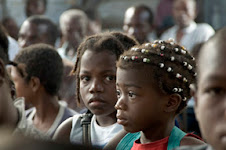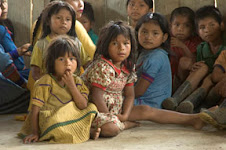


On Sunday, I went with a friend on her little motorcycle to Yuto, a town about 30 km from here. It was a nice afternoon—the rain that has lasted all morning had lifted, and I was more than ready for a break from typing and processing images. I know Yuto, a town on the bank of the Río Atrato upriver from here, and it promised to be a pleasant out.
On the road, the sky clouded up and we had a few raindrops, but not enough to take out our ponchos.
Just beyond Yuto there’s a bridge over the Atrato, and from there you get really nice views of the river. There we saw a storm in the distance, which provided a beautiful and dramatic scene.
Then the storm started to approach us, and the sky really clouded over. We went to a nice spot overlooking the river, a place where lots of people out for a Sunday afternoon seek shelter, a good view, and something to drink. We bumped into other friends there, and we two got into a lively conversation about Catholic priests who have life partners. Then a real storm hit, but after a while, it seemed to have passed. It was nearly 5 and more rain seemed unlikely soon, so we decided to return to Quibdó.
On the road, the rain began in earnest. We arrived wet, but happy. My poncho had protected my camera, so I wasn’t too concerned. My friend Nubia called it “a crazy outing,” but it had been fine.
Monday the city really got wet—in the morning, activity was at a somewhat lower level. When it really rains, there are fewer people and fewer activities in the street, naturally enough. By evening rush hour it was raining heavily again; rush hour in the rain is a lot less fun.
It’s ironic, but here in El Chocó, literally one of the rainiest places in the world, filled with rivers and streams, and an abundance of water, here in the city of Quibdó water is precious, as there isn’t an adequate system of public water service. Most people collect rainwater. The houses that are well provided with tanks make out the best, of course, since their supply will see them trough a dry spell. But for many people I know, 3 or 4 days without water can leave them with nothing in their houses.


There are pipes sticking out into the street in the center to conduct water from the roofs and gutters into the streets. When it rains, pails and other containers appear under some of these to collect water. One chicken restaurant regularly leaves out a big plastic garbage can to collect rainwater during the night. In the morning, they use it to wash the tables.
One of the great things about the rain is to see little kids—“pela’os”—run out to play in the rain and the puddles, as if it didn’t happen most days.
Except for an hour or so of brilliant sunshine Monday afternoon, basically it didn’t stop raining until 9 AM Tuesday—and the rains were strong most of the time.
El domingo, un amiga me llevó en su motica a Yuto, un pueblo que queda a unos 30 km de acá. La tarde fur bonita—la lluvia de toda la mañana había descampado, y estaba meas que listo para un receso del trabajo de escribir y procesar imágenes en la computadora. Conozco Yuto, un pueblo ribereño en el río Atrato, río arriba, y parecía que iba a ser un paseo placentero.
En el camino, el cielo se nubló y tuvimos unas gotas de agua, pero no lo suficiente para que sacáramos las capas.
Poco más allá de Yuto hay un puente sobre el Atrato, desde el cual se una panorámica linda del río. Allí vimos a un aguacero en la distancia, que nos brindó una vista linda y dramática.
Desde entonces la lluvia nos acercaba, y se nubló bastante. Fuimos a un lugar muy agradable, tipo de mirador del río, donde mucha gente al domínguear suele buscar abrigo, una beuna vista, y algo que tomar. Tropezamos con otros amigos allá, y los dos sostuvimos una conversación animada sobres los curas que tienen mujer compañera de vida. Entonces nos cayó un aguacero de verdad, pero después de un rato, aparecía que había pasado. Eran casi las 5 y más lluvia parecía poco probable, entonces decidimos volver a Quibdó.
En la carretera, la lluvia real empezó. Llegamos mojados, pero contentos. Mi amiga Nubia lo llamó “un paseo loco,” pero había sido muy bueno. Por la hora pico de la tarde había vuelto a llover, y en realidad la hora pico en la lluvia es mucho menos alegre.
Es irónico, pero acá en El Chocó, literalmente uno de los lugares más lluviosos del mundo, lleno de ríos y quebradas, con abundante agua, acá en Quibdó agua tiene valor exagerado, ya que no hay sistema adecuado de servicio público de agua. La mayoría de la gente recoge agua de lluvia. En las casas que tienen tanques buenos, se les pasa mejor, por supuesto, ya que almacenan suficiente para resistir un rato sin lluvia. Pero por mucha gente que conozco, 3 o 4 días sin agua puede dejarlos sin nada en las casas.
En el centro, hay tubos que salen para conducir agua desde las azoteas y las canaletas hacia las calles. Cuando llueve, aparecen baldes y otros recipientes debajo de estos para recoger el agua. Un restaurante de pollo frito de costumbre deja un barril grande de plástico para recoger las aguas durante la noche. Por la mañana, la ocupan para lavar las mesas.
Una de las cosas bonitas de la lluvia es ver a los niñitos—los “pela’os”—salir a jugar en la lluvia y los charcos, como si fuera algo de casi todos los días.
El lunes, la ciudad se mojó de hecho—por la mañana, la actividad era algo baja. Cuando hy una lluvia de verdad, lógicamente hay menos gente y menos actividad en la calle.
Con la excepción meas o menos una hora de sol brillante, básicamente no dejó de llover hasta las 9 AM el martes—y la mayoría del tiempo las lluvias fueron fuertes.




1 comment:
Great reead thankyou
Post a Comment